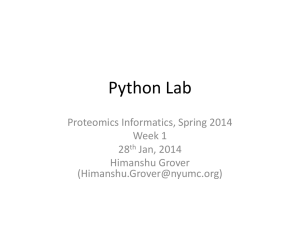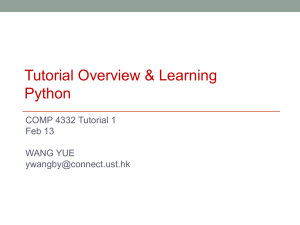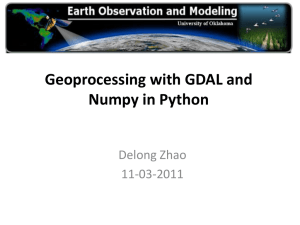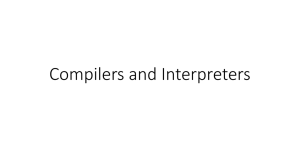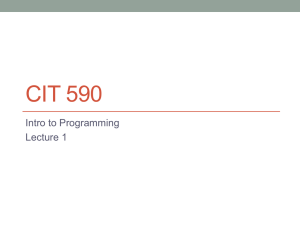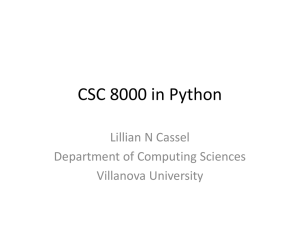Introduction - Grotto Networking
advertisement
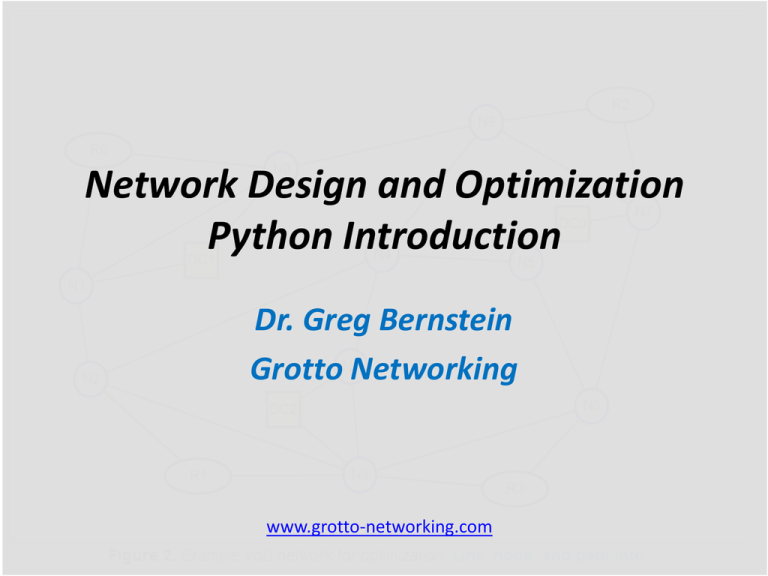
Network Design and Optimization Python Introduction Dr. Greg Bernstein Grotto Networking www.grotto-networking.com Python: The Working Dog of Programming Languages Lucy with her “reward” chew toy after finding me hiding in a closet during testing. Why Python? • Works well with Others (languages) – Relatively easy access to vast open source numerical and scientific libraries • Interactive and Object Oriented – Quick for testing out new ideas – Good for more complicated stuff too • Well used in Data Communication, Scientific, and Web Development communities – OpenStack, Mininet, PoX (cloud & SDN) – Numpy, SciPy, NetworkX, Pandas, Astropy, Sage (Math & Science) – Flask, Django, Pyramid, Tornado (Web) • Open Source! Bare bones or a Distribution? • You can get Language and Standard Library – directly from https://www.python.org/ – Then add external libraries – Issue: this can get a bit tricky on Windows and Macs • For ease of getting started there are scientific "Python distributions" available for no cost via the web. We will use Python version 2.7 due to its compatibility with numerical packages such as Numpy, Matplotlib, SciPy, NetworkX, SimPy, etc... – Anaconda (Windows, Mac, Linux) https://store.continuum.io/cshop/anaconda/ – Python(x,y) (Windows) https://code.google.com/p/pythonxy/ – Enthought Canopy Express https://www.enthought.com/products/epd/free/ Getting Started Resources • Python Tutorial – http://docs.python.org/2/tutorial/index.html • Building Skills in Python – Free PDF, Aimed at experienced programmers, Recommended – http://www.itmaybeahack.com/book/python2.6/latex/BuildingSkillsinPython.pdf • Lectures on Scientific Computing with Python – http://nbviewer.ipython.org/github/jrjohansson/scientificpython-lectures/tree/master/ – Uses IPython notebooks. Covers basics, numpy, matplotlib, and more… • Code Academy – http://www.codecademy.com/tracks/python Editors and IDEs I Use • Geany Editor – http://www.geany.org/ – Recognizes Python classes, Functions, variables; syntax highlighting, zoom; Cross platform: Linux, Windows, Mac • Notepad++ – http://notepad-plus-plus.org/ – Fast, Windows only, syntax highlighting, zoom, doesn’t recognize Python functions, classes, variables • PyCharm (full IDE) – http://www.jetbrains.com/pycharm/ – Free and professional editions • Your favorites? Python Shells • Plain Python shell – Can just type “python” at a command prompt to start and interactive shell • IPython http://ipython.org/ – A much improved command line shell – Great Qt based graphical shell (I use this all the time) – Full on Browser based notebook interface. Include nice text, code, and graphics together. – Included with Anaconda, PythonXY, and Enthought distributions and available separately Other Tools I Use • Google Python Style Guide – http://googlestyleguide.googlecode.com/svn/trunk/pyguide.html • Version Control: Git – I’ve got a slide deck on using Git locally for single person projects. • Documentation Generators (Python)? – Doxygen • Originally aimed at C++, But can now do python, but in a C++ kind of way. Easy to use. – Sphinx • Used for much Python documentation. A bit tougher to use but very pretty documentation. External Python Libraries • • • • • • Numpy (http://www.numpy.org/) SciPy (http://www.scipy.org/) Matplotlib (http://matplotlib.org/) SimPy (http://simpy.readthedocs.org/en/latest/) NetworkX (http://networkx.github.io/) PuLP (https://code.google.com/p/pulp-or/) – https://pythonhosted.org/PuLP/ Documentation • Flask (http://flask.pocoo.org/) Almost all included with Anaconda, PythonXY, or Enthought distributions Network Visualization in the Web Era • Common GUI Problems – Non-portable – Graphics library lock-in – Lack of Support • Alternative: Web based GUI’s and Visualization – – – – Raw technologies: HTML5, CSS, SVG, JavaScript Powerful JavaScript libraries: D3.js, jQuery, etc… Data sharing: JSON, XML Downside: learning curve… Our R&D Environment I • Network Editor/Viewer Web Application – http://www.grotto-networking.com/GraphEdit.html – Import and export network related entities such as graph, paths, demands, etc.. Via JSON files Web Browser Running “Single Page” JavaScript Application Graph JSON Path JSON Path JSON Path JSON Tree Demand JSON JSON JSON parser from Python standard library Our network design and optimization algorithms Open Source Solvers and Libraries as needed Our R&D Environment II • Network Editor/Viewer Web Application – Next step beyond http://www.grottonetworking.com/GraphEdit.html – Exchange network related entities via AJAX (or WebSockets) Web Browser Running “Single Page” JavaScript Application RESTful Web Service AJAX RESTful service requests, i.e., GET, POST, PUT,… Exchanging JSON data This is what I use on my machine Simple Python WebServer (Flask) Our network design and optimization algorithms Open Source Solvers and Libraries as needed Example of R&D Environment II


